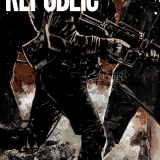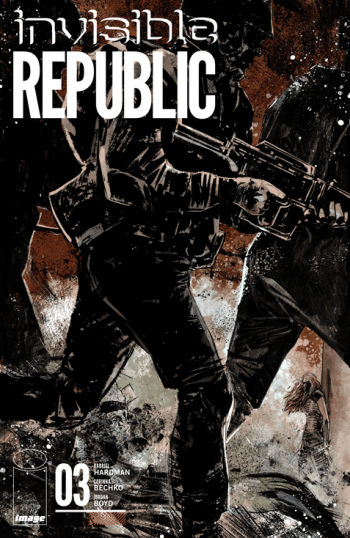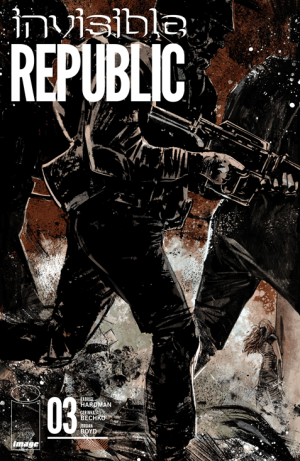
COMIC BOOK REVIEW: Invisible Republic #3 – Unbecoming
The independent series Invisible Republic is gearing to another level of reading sophistication as the story progresses further, and making more intriguing and deliberately mind-boggling on how to the future tyrant Arthur became the man he would be feared and hated with. Invisible Republic #3 presents the combination of subtlety of storytelling, and the critical […]
The independent series Invisible Republic is gearing to another level of reading sophistication as the story progresses further, and making more intriguing and deliberately mind-boggling on how to the future tyrant Arthur became the man he would be feared and hated with. Invisible Republic #3 presents the combination of subtlety of storytelling, and the critical and psychological analyses of the past and modern societies and the political institutions in place that the creative team of Gabriel Hardman, Corinna Bechko and Jordan Boyd attempt to reach out.
The story begins right from the cliffhanger from last issue that already showcases how good right now Hardman and Bechko in crafting, delivering and executing a suspenseful, fast-pacing and well-paneled tale of cat-and-mouse chase. Underlining the seeming minimal dialogues between the reporter/writer and the hunter convey the ideological differences in the search of the illusive “truths” about the future/ recently overthrown despot. One is destroying the awful facts to preserve the prevailing “official” history against the dictatorship and justifying the existing government; while the other is trying to unearth the hidden past for his own self-preservation and maintaining his apparent hedonistic lifestyle.
The sense of utilitarianism is virtually vanished in this dystopian setting, particularly in the food distribution which Hardman and Boyd almost accurately portray how hunger dominates the faces of the hoi polloi and the apathetic approach the police force commits just to unburden its thankless occupation (and the irony here is many polices hold their jobs, but still being not contented more so). The scramble scenes are executed properly and the duo gives readers a suspenseful moment whether or not the protagonist gets back his possession again.
As usual, the exploration of Arthur’s mindset continues to unravel as the pair finds themselves playing hide-and-seek with the authorities. In Maia’s own words, “family prevails” no matter whether the member’s actions are either right or wrong. Here, the ancient thoughts of the medieval concept of “family” ties and even Confucianism and Neo-Confucianism are still prevalent and resonating so well beyond the future. Admittedly, the notion of “family” as the foundation of a “society” is as ancient as we really care about. However, radical thinker Karl Marx declared the destruction of “family” in the early 19th century as it claimed to hinder the total socio-evolutionary process of humankind in the most degenerating process. Why so? Then and now, the ruling families and their family members in the political, social, economic and cultural spheres control the key or majority resources that should be accessibly inclusive to the broader demographics. How resonating Marx was (and is)!
Just look in our Philippine community, “family” is a powerful social institution, an almost unquestionable fact of life, and the inspiration of our socio-economic stability. Rich and powerful families control the political and economic realms, while the majority of us rarely climb the ladder of success unless becoming part of the elites or migrating to greener posture and economically stabled nations, where opportunities are available.
Issue three dares readers to rethink and critically analyze the current notion of “family” to the wider aspects of power-relations. And, we are already witnessing some character developments on Arthur and Maia’s sides that still both intrigue and tease me for this is the moment how Arthur dares to break the essence of “family” while being transformed into a more Machiavellian archetype. At first glance, Arthur’s actions towards Maia may be seen as a deliberate act of self-preservation. Yet, words are deceiving themselves. Hardman and Bechko probably play the game of Saussurean “signifiers”—interpreting and conveying words to many levels of interpretations/meanings of imageries. Indeed, Arthur’s “abandonment” maybe his “strategic” way of evading the current status quo, while Maia, the unsophisticated type, thinks differently (or confusingly) on her cousin’s acts. The “invisible” usage in the end of the issue is applied to maximum effect that highlight the “seen” and the “unseen”. “Family” is diminished or broken. Its core beliefs of “caring” or “looking with one another” become the vanishing, the “invisible”. Is separation another step back plan of Arthur towards his ascension to power (and his eventual downfall much later)? Or maybe, just maybe the creative team teased us for further reading to this great story arc.
Boyd’s coloring technique is one of the true measures of the book’s incredible portrayals of a dystopian society. Again, the past-to-present and vice-versa color scheme are done properly and adequately to ensure reading experience a pleasurable one. Despite the obvious three to four color technique the colorist applies, the story flows smoothly and the colors themselves laminate an interesting story of “family”. The featured essay in this issue points out the integral role of “BEES” in human history. To wit, why highlight the bees of all creatures? But by reflecting to our current socio-political-economic settings (and the series), these pollinating insects do contribute a lot (but sadly unheard and unappreciated) to our own development as a society, particularly the relevance of “family” and the roots of egalitarianism, altruism, utilitarianism and socialism that are mocked nowadays by the advocates and champions of capitalism and globalization.
Similar to the previous criticisms leveled from the last two issues, I repeat that I hardly find something new words, terminologies or phrases since the series takes place in a far long future. Hence, the English language could have involved somehow, not in the 21st century model. Second, I feel that the bag-chase scenes are performed by a superhuman, not an ordinary writer. How come the injured and newly rescued guy keeps up with the black dude with the bag (he went down a high-raise story building first while the main character was helped by bystanders and onlookers and then caught some breath here)? Did the writer use the stairs or the elevators or what? And, this issue has less action scenes than the past issues. This would not suit up for some comic readers. Perhaps, that is why Invisible Republic (and many Image titles) is directed to more intelligent group of comic readers.
Invisible Republic #3 continues the two stories that interconnect so well that even casual readers can read it without a hitch unless they want to delve the seriousness of the themes of “family”, “society”, “political-economic” dichotomy, and the fascinating psychological profile of a would-be dictator. It also continues presenting readers the overall artistic process that can a source of inspiration for potential artists of crafting good stories sooner or later. And as mentioned, the connectivity of the featured essay to the overall story here makes us reflect on something insignificant but possesses a direct and huge impact to the development of the human race. I am more and more engaged what the creative team has in-store next chapter!



















